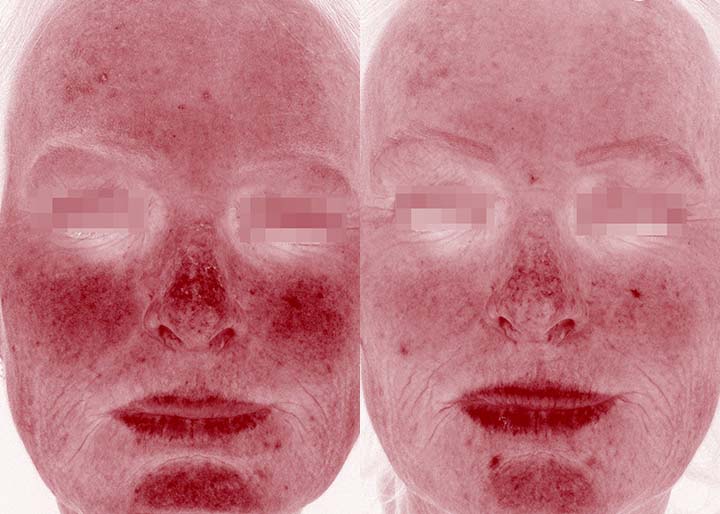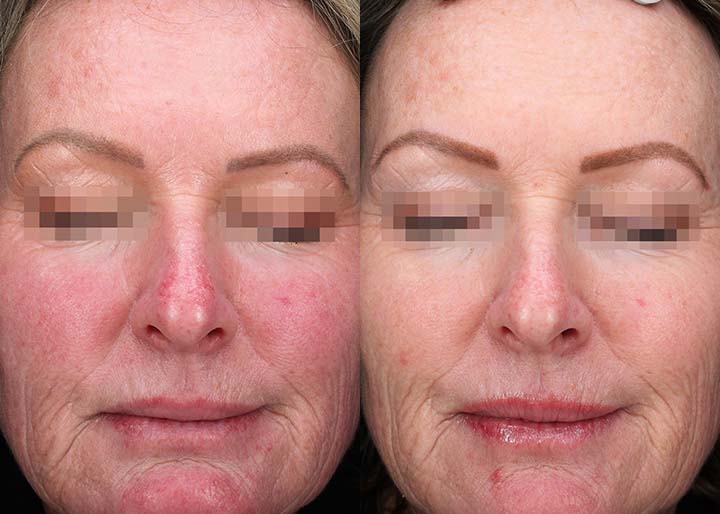Introduction
Facial redness is a very common skin problem faced by many people, particularly those with fair Anglo-celtic skin. In many instances this is caused by a chronic skin condition called rosacea.
Rosacea is a chronic inflammatory skin disorder that most commonly affects the skin of the face in both females and males with the initial onset between the ages of 20 and 50 years of age.
There is a spectrum of disease with symptoms often progressing as people get older.
Symptoms
Symptoms can vary from person to person. Most patients experience facial redness and flushing/blushing. Many have dilated capillaries particularly over the nose, cheeks, forehead and chin. Some have inflammatory lesions (papules and pustules) and pitted and thickened skin (particularly around the nose).
Four clinical types of rosacea can be identified:
- Erythrotelangiectatic form: background facial redness,
- Papulopustular form: inflammatory lesions especially over the nose, cheeks, forehead and chin,
- Rhinophyma: pitted and thickened skin particularly over the nose,
- Ocular form: eye irritation.
Causes
There is a strong genetic component, and an increased presence of microscopic skin mites (Desmodex mite) has been identified. An altered immune response in the skin plays a factor. There is impaired barrier function of the skin. Ultimately the result is chronic skin inflammation which leads to the symptoms described above.
Numerous triggers have been observed to increase the frequency and severity of the symptoms of rosacea. These include, sun exposure, temperature change (for example hot showers), alcohol, spicy/hot foods, caffeine, emotional stress, smoking, concurrent illness, poor sleep and various topical products (harsh cleansers, exfoliating agents).
There has been an explosion of knowledge regarding the causes and factors involved in the pathogenesis of rosacea.
TREATMENT Rosacea is a chronic medical condition and therefore treatment needs to be consistent and ongoing. Often a combination of treatments are needed for successful management and control of this condition. General treatment principles need to be followed:
1. Avoidance Of Triggers
Strict daily sun protection including application of a broad spectrum and high SPF sunscreen is absolutely essential.
Avoiding the use of potential skin irritants, such as aggressive mechanical exfoliants, harsh cleansers and various perfumed cosmetics.
Some commonly utilised dermal treatments (such as microdermabrasion and chemical peels) can potentially worsen the inflammation seen in rosacea. This is why it is essential to see a doctor prior to having any skin treatments performed.
3. Improvement of barrier function
The consistent use of appropriately prescribed skin care cannot be underestimated. A hallmark of rosacea is an impaired barrier function. This important function of the skin can be repaired with removal of skin irritants and addition of appropriate skin care.
2. Reduce inflammation
Tetracycline antibiotics*, through their anti-inflammatory properties are useful to treat and control the inflammatory lesions (papules and pustules) of rosacea. These are not used for their antibiotic mode of action.
A topical prescription skin cream*, that targets the Desmodex mite in the skin of rosacea suffers, is available to improve the appearance of the inflammatory lesions and background redness.
Prescription medication*, that is often used to treat severe acne, can also be used in patients with rosacea that has not responded to other therapies.
Background redness, flushing and blushing that is particularly an issue in certain situations (such as with public speaking or in work meetings) can be improved with the application of a topical prescription gel*. This works by causing vasoconstriction of the vessels involved.
Vascular laser directly treats underlying inflammation which when used regularly, leads to an improvement in background redness, flushing and blushing, visible vessels and skin texture.
HOW ARE WE UNIQUE
Rosacea is a medical dermatological condition and needs a medical management plan. Each person with rosacea suffers in a slightly different way, which is why we personally assess every patient and develop an individualised treatment plan to manage the symptoms of rosacea both in the short and long term.
*As medical doctors and the fact that this is a prescription medication we are not allowed to mention the ingredient by name.
Before and After Rosacea Treatment

Before and 6 weeks after vascular laser and prescription skin care
Before and 6 weeks after vascular laser and prescription skin care
Results may vary depending on the individual response to treatment
Do You Have A Question?
Please complete the form below and we will be in touch ASAP.







